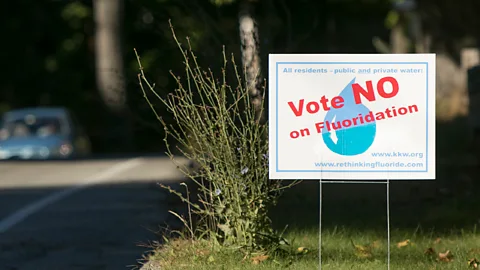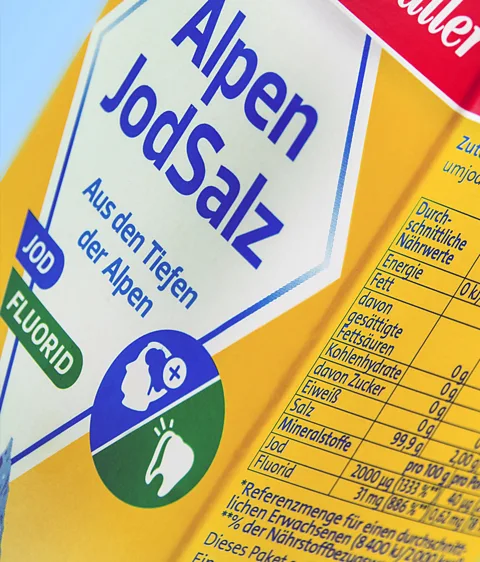 Getty images
Getty imagesWith the fluoridation of drinking water water under the spotlight in the United States, we examine why some countries choose not to add the mineral to supplies while others have repealed the practice.
In the United States, around 63% of the population – 209 million people – Receive fluorinated water. For nearly 12 million people, the mineral is not added, but naturally occurs in the water supply.
Those who oppose the artificial fluoridation of drinking water Hang often to the fact that Most countries of the world Do not add the mineral to the water. But is it true? And, if this is the case, why did these countries not fluorist their water – and what were the results?
 Getty images
Getty imagesThis is particularly noticeable for children from more socio-economicly private environments.
“The fluoridation of community water is to fill the gap between poor and wealthy people,” said Zohoori. “He reaches everyone – the whole population, not just specific people – so reduces general health inequalities.” She underlines the difference between the city where her university is located, Middlesbrough, in Yorkshire in northern England, compared to the neighboring city of Hartlepool. The two communities are socio-economicly disadvantaged. But Hartlepool water has natural fluorine levels up to 1.3 mg / lWhile Middlesbrough does not do it. “”Middlesbrough is one of the counties with the highest levels of dental caries in childrenWhile Hartlepool has much less, “she said. In March, the Ministry of Health and Social Coins of England Recommended expanding community water fluoridation in regions of northeast of England, including Middlesbrough.
The concerns concerning excessive fluoride consumption are one of the reasons why certain countries have chosen not to artificially fluorider their supply of water – but only because their drinking water already has naturally high fluorine levels.
Fluoride occurs in the ground, plants and water. Certain types of rocks and soil have higher concentrations than others. “It really comes back to geochemistry,” explains Joel Podgorski, principal scientist of the Swiss Federal Institute of Aquatic Sciences and Technologies in Dübendorf, Switzerland. “Some lithologies have more of these minerals containing fluorine.” In particular, he notes, Igneed rocksLike those formed by lava, tend to contain more fluorine.
The presence of rocks containing fluoride can increase fluorine levels in groundwater. In Italy, for example, concentrations of fluoride in water vary from approximately 0.1 to 6.1 mg / L – but in zones with volcanic rock, fluoride levels can reach up to 30.2 mg / L. In certain regions, such as Laziiota or Calabria, fluoride is actively removed, or water is diluted in order to keep public supplies below 1.5 mg. / The recommended by the WHO And the EUsaid Tommaso Filippini, associate professor of epidemiology and public health at the Italian University of Modena and Reggio Emilia. Filippini is the author Several articles on fluoridation.
But there are a variety of other reasons why countries were not fluorulating their water supply.
However, countries that have ceased water fluoridation programs did not say that they had done so because the authorities were concerned about public security, said the main author Mary Roseney, a public health researcher who, at the time of publication, worked at the Dublin City University in Ireland and now works in the Royal College of Surgeons in Ireland and is vice-president of the Nutritional section Safe Association.
Instead, some countries have cited public complaints, such as people who thought it was a violation of their human rights, or said that it was up to individuals to manage their own fluorine consumption. Others pointed out that their populations had enough fluoride elsewhere. Out of 11 countries that had ceased their fluoridation programs, only two questions cited security and efficiency – Finland said that fluoride efficiency had not been proven, while the Czech Republic cited the “debates” on the safety and efficiency of fluorit. None said they had stopped fluoridation because they had determined that fluoride was harmful.
For some of these populations, fluoride was naturally available in drinking water, but for others, some food and drinks contained fluoride. According to the 2018 report, Bulgaria fluoted its milk while Greece added the mineral to bottled water.
These different approaches to fluoride also exist outside the EU, explains Zohoori, who is currently carrying out a study comparing national fluorineal patterns in Brazil, the United Kingdom, Colombia and Chile. “Some countries, such as Switzerland, have a fluododed salt,” she said. “Brazil has fluoridated water; Colombia, fluorida salt; Chile, fluoridat milk.”
 Getty images
Getty imagesA 2012 review of Asian countries found that countries that have chosen not to fluordinate their water generally did it for one of the three reasons: high levels of natural fluoride (as in certain parts of India); technical or financial obstacles (as in Nepal); Or because fluoride has been provided to communities in other ways.
Take Thailand, which does not fluoride its water but which has the largest milk fluorum program in the world. Milk enriched with 2.5 mg / l of fluoride is provided to more than a million children per day, free of charge, in public schools. Children also receive fluoted milk during school holidays. The Thailand program includes oral health education, controls, fluorine varnish – a varnish containing fluorine applied to the teeth, generally by a dentist – and brushing sessions supervised with a toothpaste containing fluorine. A study revealed that at the cost of only 11.88 THB ($ 0.40) per child, per year, This approach has reduced the prevalence of children’s dental cavities of more than a third party.
Meanwhile, the fluoritation of salt is the second most common way so that countries deliver the mineral to their populations, after the fluoridation of drinking water, According to a 2018 review. The first country to add fluorine to salt was Switzerland. Table table there is contents of fluoride since 1955.
Zohoori says salt may not be the best option overall. “As a nutritionist, I don’t want to promote salt consumption,” she said. “For me, fluorinated water is the best method.”
Access to dental care can also influence the decisions of countries to fluorider water. A 2015 study found enormous disparities in access to dental health care – generally linked to better oral health – between the United States and a selection of European countries. In five of the 10 European countries questioned, more than 75% of respondents had dental coverage. This included 98% of respondents in Germany, 96% in the Czech Republic and 92% in Denmark. In the United States, only 48% had dental coverage in comparison.
 Getty images
Getty imagesHowever, Zohoori requests care when considering the relatively low levels of water fluoridation in Europe as a reason to stop doing it elsewhere. Europe, she underlines, does not have an excellent dental health file. A 2023 that reports found that Europe had the highest prevalence of major oral diseasesIncluding the most cavities in permanent teeth, from any region of the world. More than one in three adults had dental cavities.
The researchers also found that the children of Japan who lived in regions with more natural fluoride had fewer cavities. Each increase of 0.1 part per million fluoride concentrations was correlated with A reduction of approximately 3.3% in the prevalence of cavities. “This observation suggests the possibility of reducing dental cavities by using fluorine at a population level in Japan,” wrote the authors of the study.
While some countries such as the American debate removal of water fluoride, other regions, in particular, have made such a step to reverse it. A famous example is Calgary, CanadaWho stopped fluoridation of its local water diet in 2011 – then, after an increase in dental caries, decided to restore fluoritation earlier this year.
“In the end, if fluoride is removed from water, it will be another health inequality. It will be the disadvantaged communities that will feel the effects disproportionately,” said Sweeney.
For information of trust on better health and better well-being rooted in science, register for Health Newsletter,, while The essential list Offers a sorted selection on the functional and information pane.



